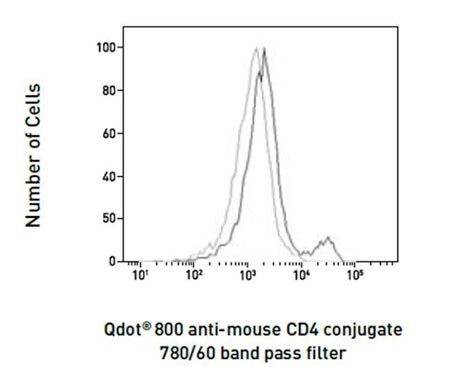Search
Qdot 800 Probe

 |  |  |  |  |  |  |
| 5 | 633 | 780/60 | 300 | 792 | (in buffer) 5 | microscopy, flow cytometry |
Invitrogen Qdot 800 probe is an excellent near-IR–fluorescent label with outstanding brightness and photostability for imaging and flow cytometry applications. With an emission maximum of ~800 nm, Qdot 800 probe can be excited using any laser line from 350 nm up to 633 nm or a standard Cy5.5 filter. Optimum imaging results with brighter signals are achieved with a Qdot 800 filter or light cube.
Organic fluorophores and Qdot probes can be readily combined in multiplexed flow cytometry or imaging studies. Longer-wavelength Qdot probes are also well-suited for multiplexed western blots.
We offer Qdot 800 probe conjugated to a variety of antibodies, peptides, and proteins, optimized for cellular labeling and detection. In addition, reactive dye forms and antibody labeling kits are available to allow you to generate your own antibody conjugates or probes.
Qdot Label Conjugates for Cell and Tissue Staining Search Qdot 800 primary antibodies

Qdot Probes
Qdot probes are made from nanocrystals of semiconductor material and are broadly compatible with standard fluorescence techniques, but there are some novel aspects to their use that can be optimized to obtain the best possible results. The exceptional brightness and photostability of Qdot probes make it easier to detect low-abundance targets. With narrow and symmetric emission spectra, Qdot probes are also well-suited for multiplexed fluorescence detection using a combination of Qdot probes and organic dyes.
Additional resources
Flow cytometry protocols handbook
Protocols that fit your needs in flow cytometry ranging from sample preparation to numerous cell stimulation conditions, staining, immunophenotyping, and data analysis strategies.
Fluorophore and reagent selection guide for flow cytometry
A handy reference poster featuring the broad range of our available dyes and labeling reagents.
Imaging protocol handbook
Protocols that fit your needs in imaging ranging from sample and assay preparation to staining, labeling, and data analysis strategies.
Fluorophore and reagent selection guide for cell imaging
A tool for selecting the optimal fluorescent dyes for your Invitrogen EVOS cell imaging systems.
Cy™ is a trademark or registered trademark of GE Healthcare.
Not for resale. Super Bright Polymer Dyes are sold under license from Becton, Dickinson and Company.
Brilliant Ultra Violet™ and Brilliant Violet™ are trademarks or registered trademarks of Becton, Dickinson and Company or its affiliates, and are used under license.
For Research Use Only. Not for use in diagnostic procedures.



